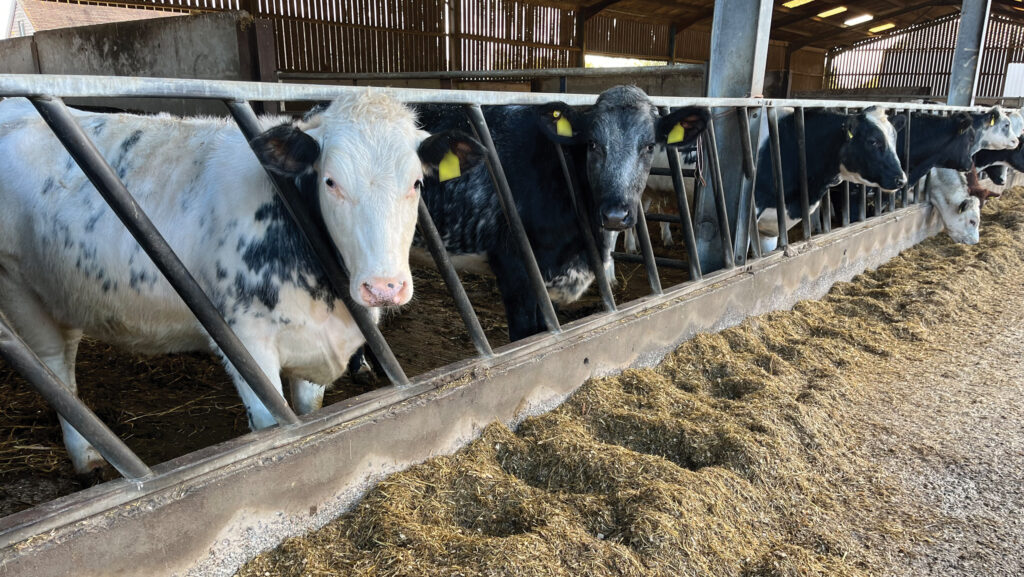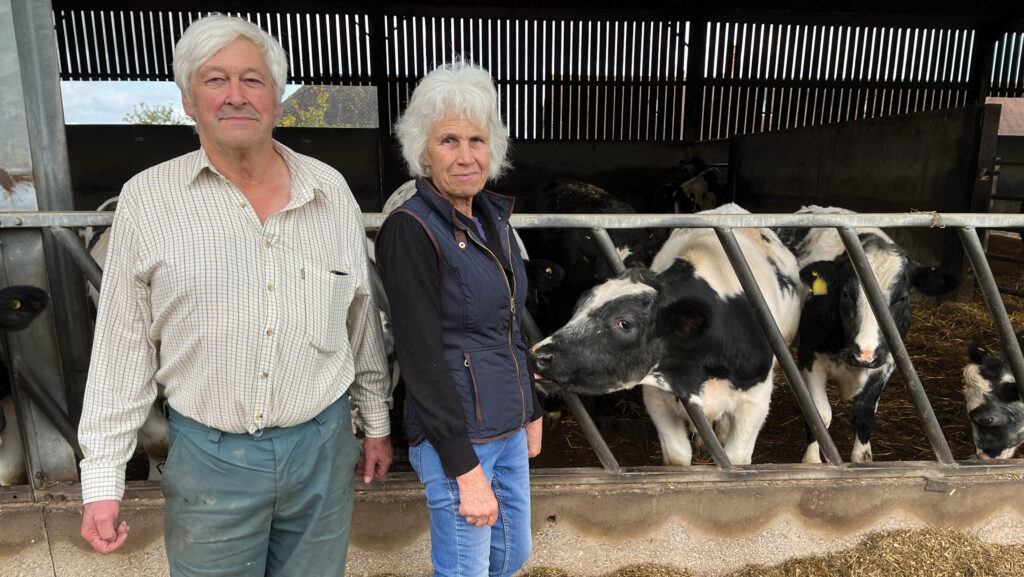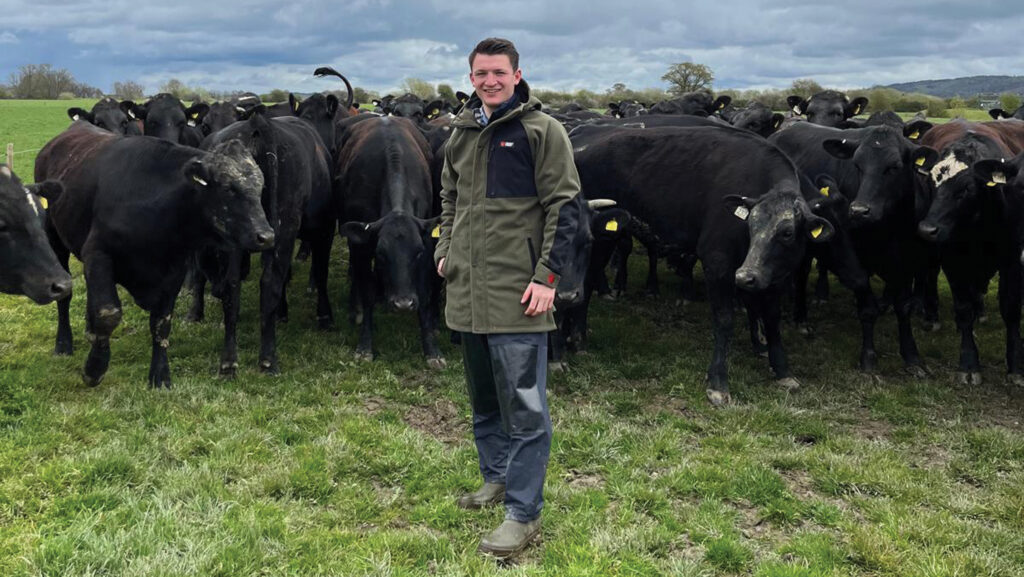Why a suckler unit joined an integrated beef scheme
 © Hayley Chapman
© Hayley Chapman For Stephen and Gretta Hodges, an integrated supply chain offered a beef enterprise with less risk, a smaller workload and more flexibility in terms of succession.
They had been farming 180 suckler cows at Oak Tree Farm, Aylesbury, but have reduced the herd to 60 head and now predominantly use their shed space to rear dairy beef cattle for Woodhead Bros’ Elite Beef scheme, supplying Morrisons.
See also: 7 focus areas for efficient beef finishing rations
Farm facts: Oak Tree Farm, Buckinghamshire
- Beef, arable and contracting, with storage unit diversification
- 405ha plus contracting
- Chopping 2,630ha of grass and maize a year
- 60 suckler cows, finishing all stock
- 400 cattle a year finished in supply chain scheme
- 150 cattle a year finished – sourced privately
“This gave us a system that is easier to deal with,” Stephen says.
“Safety-wise, they [the cattle] will lick you to death, but they won’t run you over. You don’t want to be run over at any age, but we are both in our 70s, so it’s an important factor.”
Succession was also a consideration. “My daughter will take over,” he says.
“She has purchased land in her own right but is an accountant by trade, so I wanted a system that is simple to manage, simple to hand over and can be easily changed.”
The Hodges received their first calves in January, having already supplied Morrisons for about 20 years.
Reducing the suckler herd by two-thirds means these cattle can graze exclusively in nearby fields when not housed, easing management.
Previously, suckler cows were also kept away from the homestead.

Stephen and Gretta Hodges © Hayley Chapman
Management
Taking in batches of 100 dairy beef calves, averaging 140kg at about 4.5 months old, the Hodges will see them through to finish.
“We want to get them off the farm in under 14 months weighing 650kg,” Stephen explains.
“We’ve got 440 head on farm now and we plan to turn the Angus-cross out next spring, but Blues will stay in.”
The farm buys the calves (the scheme allows outright purchase or finance agreements) and pays for all inputs such as feed, bedding, vets’ bills and haulage to Woodheads’ abattoirs.
“We manage them without interference,” Stephen says.
Husbandry
All calves are British Blue, Angus or Shorthorn dairy-cross and come from Buitelaar calf-rearing units.
Before leaving the rearer, they are vaccinated for pneumonia and infectious bovine rhinotracheitis, drenched for coccidiosis, weighed and TB tested.
In addition, they must be hitting specification to move on to a grower.
“All we would have to do as a routine is a wormer for cattle turned out,” says Gretta, who looks after all husbandry.
“The most annoying thing is the TB tests – we now have the post-movement tests and all the radial tests.”
Day to day, the system has become quite automated, with sheds littered using a bale shredder and a total mixed ration (TMR) fed with a feeder wagon.
Stephen says the attention to detail required in the early days is the most challenging part.
With 100 calves arriving at one time, it is “impossible to think you wouldn’t have any issues with them”, so checking them has to be thorough.
The batch is split into two groups of 50 to help with this, and daily bedding down enables the Hodges to check calves are “up and about”.
Stephen explains: “We put them on an ad-lib nut to start with and we would feed approximately 5t per 100 [calves], which maintains the diet they’ve been used to.
“Then we gently ease them onto a TMR.”
Finishing targets
The contracting side of the business at Oak Tree provides the farm with plenty of straw and forage, so diets are forage-heavy.
Cattle are finished on a TMR of grass silage, maize silage, biscuit meal and rapemeal. A 34% protein blend has substituted for the rapemeal when it has not been available.
As animals grow, the maize proportion of the diet is increased. “We need 6,000-7,000t of maize and grass silage each year – we have clamp capacity for 8,000t,” Stephen says.
This is grown on about 162ha (400 acres) of the Hodges’ own land and a further 81ha (200 acres) elsewhere.
Suckler progeny are fed a very similar ration to the Elite Beef cattle during the finishing period, while suckler cows provide a good way to utilise lesser-quality silage.
Because the plan is still to buy in and finish 150 head over and above the scheme cattle, diets will be adjusted if necessary.
For example, sometimes some older, “plain” cattle will be bought, and they will need a longer finishing period and their ration adjusted depending on their requirements.
Elite Beef scheme numbers
- Average days on a grower-finisher farm (140kg to finish): 389
- Average deadweight: 327.8kg
- Average slaughter age 17.7 months
- Target carcass grades: O+3/4L and R3/4L
Averages across Blue-cross and Angus-cross calves – across all suppliers, not specific to Oak Tree Farm
Source: Morrisons, supplied at a recent Elite Beef open day at Oak Tree Farm

Independent nutritionist, Charlie Cooper-Harding © Charlie Cooper-Harding
Nutrition
The farm has recently started working with independent nutritionist Charlie Cooper-Harding of Elite Beef Diagnosis.
As well as advising on rations throughout the system, he focuses heavily on the transition of cattle from weaning into the growing unit.
“Every time an animal changes diet, it’s going to take that rumen two weeks [to adjust],” Charlie explains.
For that reason, he recommends growers to use the same or very similar concentrate to that fed by the calf rearers.
He also recommends that the TMR is offered straight away, with concentrate fed on top. Then, every couple of weeks, the concentrate is reduced to increase TMR intake.
“There are rations to suit all systems,” says Charlie, who works with what the farmers have available to them, which will vary according to their farming system and location.
Example rations being developed for Oak Tree Farm |
|||
|
|
Weanling (150-300kg) |
Grower (300-500kg) |
Finisher (500kg-plus) |
|
Feeding plan (kilograms as fed a head a day) |
|||
|
Grass silage (analysed) |
7 |
9 |
6 |
|
Maize silage (analysed) |
7 |
12 |
20 |
|
Bread waste |
1 |
2 |
4 |
|
Protein blend |
2.5 |
2 |
2 |
|
Ration nutrients (units as stated) |
|||
|
Dry matter (DM) intake (kg/day) |
7.3 |
9.8 |
13 |
|
Metabolisable energy (MJ/kg DM) |
11.8 |
12.1 |
12.8 |
|
Protein (% DM) |
16.7 |
14.9 |
12.7 |
|
Starch (% DM) |
25.6 |
28.9 |
38.3 |
|
Starch plus sugar (% DM) |
27.9 |
31.2 |
40.6 |
|
Neutral detergent fibre (% DM) |
33.6 |
34.7 |
32.9 |
|
Source: Charlie Cooper-Harding, Elite Beef Diagnosis |
|||
“I believe that fibre is the key to any rumen, and before we even look at a diet, we need to make sure the neutral detergent fibre [NDF] is right,” says Charlie.
“Whether it’s by-product, whether it’s ad-lib systems, or whether it’s a forage-based system like this, if that digestible NDF level isn’t right, then it’s an uphill and costly battle from the start.”
“As a simple KPI, we need to be targeting a daily liveweight gain of over 1.35kg all the way through,” he adds.
“In a well set-up beef unit with all the non-nutritional factors right, such as space and ventilation, daily liveweight gain could be nearer 1.8kg/day on a straw and concentrate diet, around 1.45kg/day on a forage-based diet and around 0.9-1kg/day if grazing,” he says.
“We need to be efficient in terms of feed that’s going in and meat that’s coming out.”
